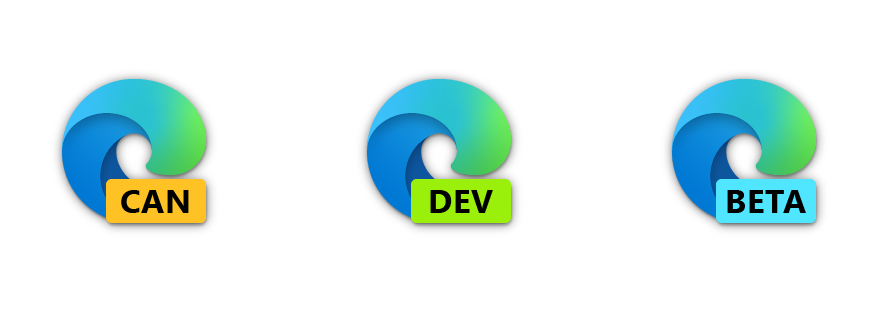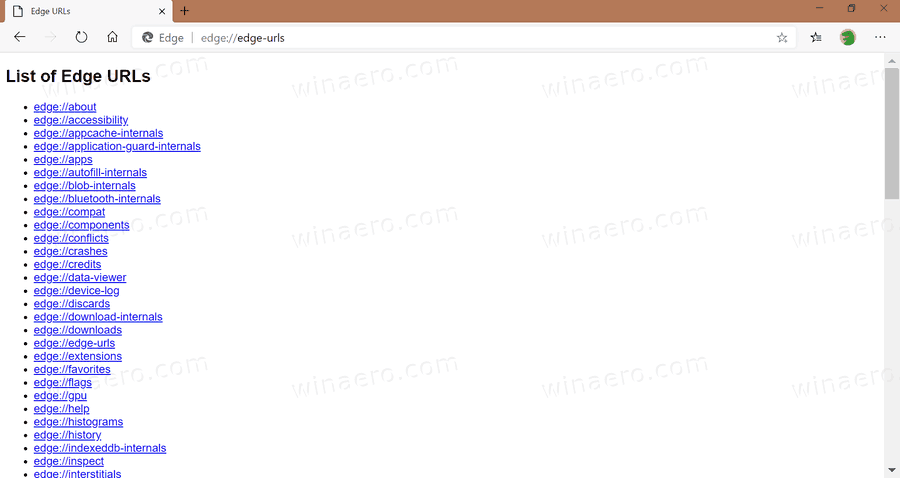The List of Internal Page URLs in Microsoft Edge Chromium
Microsoft Edge, similar to Google Chrome, Opera, and other chromium-based browsers, includes a list of internal web pages which can provide extra details about various browser features, allow changing them, and even simulating web page errors.

Microsoft Edge is now a Chromium-based browser with a number of exclusive features like Read Aloud and services tied to Microsoft instead of Google.
Advertisеment
The stable version of Microsoft Edge Chromium is available to the public for a while. The browser has already received a few updates, with support for ARM64 devices in Edge Stable 80. Also, Microsoft Edge is still supporting a number of aging Windows versions, including Windows 7, which has recently reached its end of support. Check out Windows Versions Supported by Microsoft Edge Chromium. Finally, interested users can download MSI installers for deployment and customization.

For pre-release versions, Microsoft is currently using three channels to deliver updates to Edge Insiders. The Canary channel receives updates daily (except Saturday and Sunday), the Dev channel is getting updates weekly, and the Beta channel is updated every 6 weeks. Microsoft is going to support Edge Chromium on Windows 7, 8.1 and 10, alongside macOS, Linux (coming in the future) and mobile apps on iOS and Android.
Internal Page URLs in Microsoft Edge Chromium

Most of the Chromium-based browsers have their own protocol for internal pages. In Chrome it is chrome://something, in Opera it is opera://something. For Edge, Microsoft is using the edge protocol name that allows you to access its internal pages. For example, edge://sandbox shows the status of the sandbox feature in Microsoft Edge.
Here is the list of internal URLs which are available in Edge.
The list of internal URLs available in Edge
| Microsoft Edge URL | Description |
|---|---|
| edge://about | The list of all built-in page URLs. Similar to edge://edge-urls/ |
| edge://accessibility | Change accessibility mode, see available capabilities. |
| edge://app-service-internals | Shows available app services |
| edge://application-guard-internals | Shows the state of Application Guard on Windows. Includes logs, host information, and a few tools to check URL trust, ping, and more. |
| edge://apps | The list of installed apps in Microsoft Edge. |
| edge://autofill-internals | Shows autofill logs. |
| edge://blob-internals | The list of blob data (if present). |
| edge://bluetooth-internals | Bluetooth details, such as adapters, devices, and debug logs. |
| edge://collected-cookie-dialog | A cookie-specific page |
| edge://compat | The Compatibility hub. Includes Enterprise Mode Site List entries, User agent overrides, CDM overrides, and the status of Internet Explorer mode (including diagnostics). |
| edge://components | Installed plugins and components. |
| edge://conflicts | The page lists all modules loaded in the browser and rendered processes, and modules registered to load at a later point in time. |
| edge://connectors-internals | Shows available enterprise connectors. |
| edge://conversion-internals | Attribution Reporting API Internals |
| edge://crashes | Lists all recently logged and reported crashes. Also on this page you can clear the logs. |
| edge://credits | Shows credits for various components and features included in Edge. |
| edge://data-viewer | View diagnostic data. |
| edge://device-log | Provides information for device Edge can interefere with, like Bluetooth, USB devices, etc. |
| edge://discards | The list of tabs that may be discarded, e.g. to turn them into "sleeping tabs" to free up system resources. |
| edge://download-internals | Displays the status of the current download(s) (if any). There is also an option to start a new download. |
| edge://downloads | The built-in download manager page listing all downloads of Edge. |
| edge://edge-dlp-internals | Data loss prevention page. |
| edge://edge-urls | Lists all built-in page URLs. Same as edge://about |
| edge://extensions | The extension manager that shows all the installed extensions and their options. |
| edge://favorites | Open Bookmarks. |
| edge://flags | Opens the experimental feature editor to enable or disable hidden options not exposed anywhere in the GUI. |
| edge://floc-internals | FLOC details for user tracking. This is a Chromium-specific page. |
| edge://gcm-internals | A Chromium-specific page. |
| edge://gpu | Lists details and capabilities of the graphics adapter. Also shows driver bug workarounds and potential issues. |
| edge://help | Shows the installed version of Microsoft Edge and performs an update check. |
| edge://histograms | Page load stats from the browser start to the last open page. |
| edge://history | Browsing history. |
| edge://indexeddb-internals | IndexedDB usage details by sites. |
| edge://inspect | Allows setting network targets and port forwarding for USB devices. |
| edge://interstitials | The list of service pages that Edge displays when it hits into an SSL error, detecs a captive portal, or for a lookalike URL. |
| edge://invalidations | Invalidations debug information. |
| edge://local-state | Browser features and policies, and their status in JSON format. |
| edge://management | Page is only avaialble if some Group Policies are applied to the Edge browser. The browser also shows a "managed by a company or organization" banner in its UI. |
| edge://media-engagement | Lists media engagement options, and displays sessions. |
| edge://media-internals | Some more details about media |
| edge://nacl | NaCl (Native Client) information. |
| edge://net-export | Allows creating a network log. |
| edge://net-internals/#dns | Clear host cache. |
| edge://net-internals/#hsts | Manage domain security policy settings. |
| edge://net-internals/#proxy | Re-apply current proxy settings, or remove inaccessible proxies. |
| edge://net-internals/#sockets | Allows the user to close idle sockets and flush socket pools. |
| edge://network-errors | Displays the list of network errors that Edge may throw. |
| edge://newtab | Opens the default New Tab page. |
| edge://ntp-tiles-internals | Shows configuration details for New Tab Page, for example, if the Top Sites option is enabled or not, the list of its sites, and so on. |
| edge://omnibox | Shows address bar input results on the page. |
| edge://password-manager-internals | Shows the built-in password manager internal details. |
| edge://policy | Lists Group Policies applied to Edge. Here you can also export them to a JSON file. |
| edge://predictors | Auto-complete and resource prefetch predictors. |
| edge://prefs-internals | Edge preferences and their values in JSON format. |
| edge://print | Print Preview page. |
| edge://process-internals | Site isolation mode information. Includes the list of sites that are isolated. |
| edge://push-internals | Push Messaging debug snapshot. |
| edge://quota-internals | Disk quota information including available free disk space for the profile directory. |
| edge://sandbox | The sandbox status for Edge processes. |
| edge://serviceworker-internals | Service Worker details. |
| edge://settings | Opens the browser's Settings. |
| edge://signin-internals | Sign-in status, refresh tokens, email addresses and other details for the user account. |
| edge://site-engagement | Shows site engagement scores for every visited site. |
| edge://sync-internals | Advanced details on synchronization in Edge. |
| edge://system | OS details, including Edge and Windows version, resource usage, and more. |
| edge://terms | The End-User License Agreement. |
| edge://tracing | Record, load, and save trace data. |
| edge://translate-internals | Extra details for the built-in translator. |
| edge://ukm | Metric collection |
| edge://usb-internals | Allows testing USB devices. Includes a device list. |
| edge://user-actions | Lists user actions. |
| edge://version | Edge version information including command line parameters and variations (experiments). |
| edge://web-app-internals | Installed app details in JSON format |
| edge://webrtc-internals | Allows creating WebRTC dumps. |
| edge://webrtc-logs | Recently created WebRTC text and event logs. |
| edge://surf | Play the built-in Surf game. |
| edge://whats-new | Inherited from Chromium. In Google Chrome, it shows the most recent additions to the browser. As of this writing, does nothing in Edge. |
Source: Kamran Mackey via msfntext.
Support us
Winaero greatly relies on your support. You can help the site keep bringing you interesting and useful content and software by using these options:
